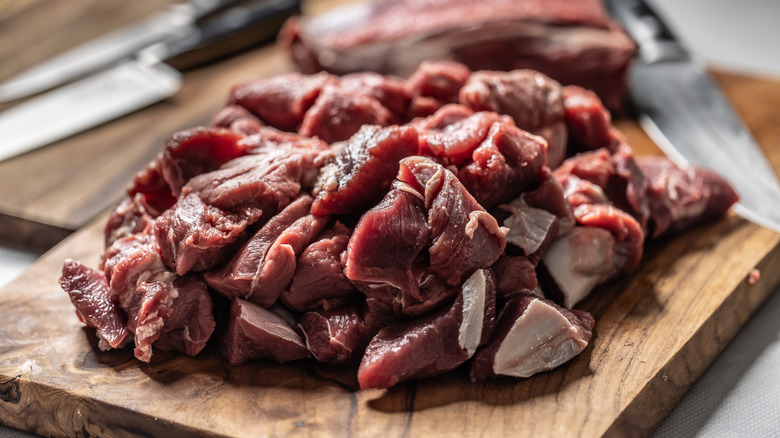What's The Best Steak For Steak-And-Ale Pie?
Pies of various sizes, shapes, and flavors have a long history, dating back at least as far as ancient Egypt. It seems humans have always had a predilection for enveloping our favorite foods in flaky crust — and steak-and-ale pie is no exception. Baked in a flaky, buttery crust full of savory vegetables (everything from celery and onions to mushrooms and carrots is traditional), rich gravy flavored with robust brown ale, and cubes of tender steak, this dish has been a favorite in pubs and home kitchens alike for centuries.
Like many foods invented by non-noble classes, steak-and-ale pie was originally in a class of meals designed to be both filling and affordable — characteristics crucial to foods in working people's diets. Root vegetables and mushrooms could be easily foraged in many areas, or grew in abundance in the private kitchen gardens that were a common feature of working-class homes. Hearty meat pies also offered an excellent way to break down and tenderize the cheaper cuts of meat available in these areas of society.
Cheaper cuts of meat were tougher and needed longer cooking times in plenty of moisture to become tender and juicy. This is important to keep in mind when choosing cuts of beef to recreate this meal at home. Tender, more expensive beef will just melt and become soggy, so it's doubly worth it to look for leaner, relatively fibrous cuts — your pie will turn out better, and your wallet will thank you.
Specific cuts of beef that work perfectly in steak-and-ale pie
When choosing beef for your steak-and-ale pie, it's best to avoid anything you'd put on the grill or lovingly sear on the stovetop. Cuts like chateaubriand, T-bone, porterhouse, or filet mignon simply aren't suitable for this hearty dish, as they don't need hard cooking to become tender — they already are. Braising any of these cuts of meat inside a savory pie would simply cause them to soften and fall apart, and not in a good way. They'd become mushy and rob the other ingredients in the pie of their structural integrity.
Instead, look for anything labeled as "stewing" or "braising" meat to ensure you're getting beef that can withstand long cooking times nestled in a bed of veggies and gravy. If your local grocery store lacks these convenient labels, look for big pieces of chuck roast, beef shoulder, skirt steak, or beef shin. When in doubt, ask the butcher behind the counter, as they'll be able to steer you toward what you'll need.
Once you've got the right kind of beef for your pie, it's time to prep to ensure you get the right end texture. Most recipes call for the beef to be cubed and seared before you pop it in the pie crust, to help lock in juices. If you time it right, you can do this while blind-baking your pie crust in the air fryer so they're both ready at the same time.

